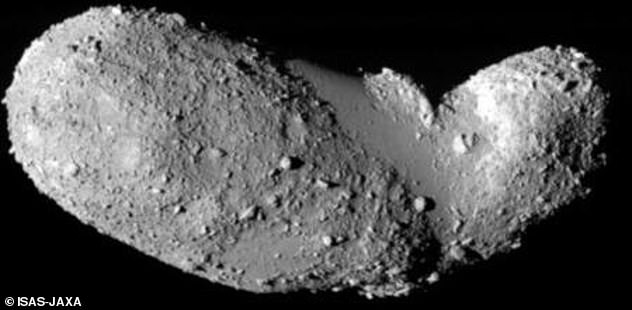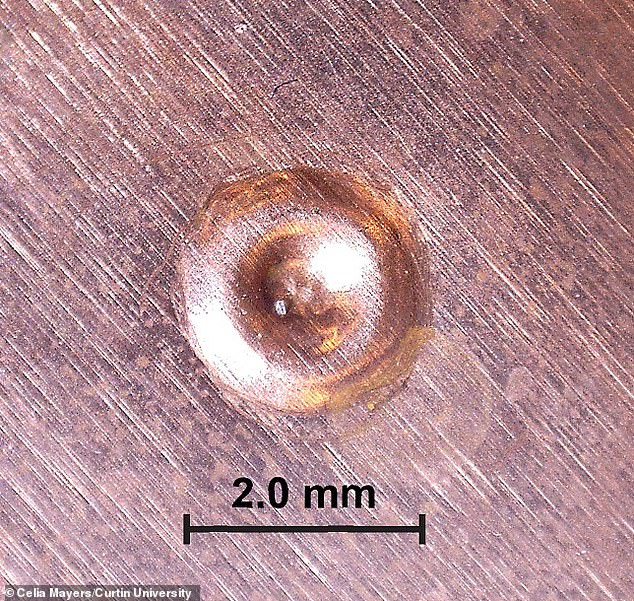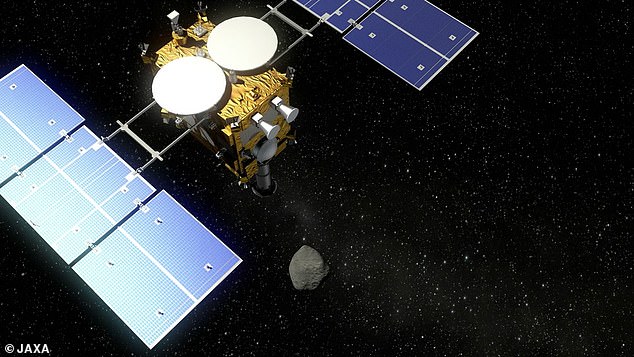Asteroid the size of Sydney Harbour Bridge is ‘hard to destroy’, study finds
>
Deflecting a massive space rock could one day be the only way to save our planet from a catastrophic impact that spells an end to humanity.
And through last year’s DART mission, NASA has already shown how such a rock could be thrown off a collision course with Earth by crashing a spacecraft into it.
But what if a satellite plunges straight through an asteroid, failing to alter its course?
Unfortunately, a new study claims that Itokawa, an asteroid the size of Sydney Harbour Bridge, would be ‘very hard to destroy’ as it’s resistant to collision.
Artist’s impression of Itokawa, an ancient and potentially hazardous asteroid made of rocky rubble and dust
Itokawa is made up of loose boulders and rocks that have clumped together under the influence of gravity, so much of it is empty space.
For this reason, it’s known as a ‘rubble pile’ asteroid, rather than a single large chunk of rock (‘monolithic’).
And despite being around 1.2 million miles (2 million km) from Earth, Itokawa is still officially deemed ‘potentially hazardous’ that could do damage if it reached Earth.
The new study was led by experts at Australia’s Curtin University, who analysed samples of Itokawa that were collected by the Japanese space probe Hayabusa and returned to Earth in 2010.
‘Unlike monolithic asteroids, Itokawa is not a single lump of rock, but belongs to the rubble pile family which means it’s entirely made of loose boulders and rocks, with almost half of it being empty space,’ said lead author Professor Fred Jourdan.
‘In short, we found that Itokawa is like a giant space cushion, and very hard to destroy.’
The team used two complementary techniques to analyse the three dust particles from Itokawa, which is approximately 1,100 feet (330 metres) in diameter.
The first, electron backscattered diffraction, can provide information about the structure of a material, and if it has been shocked by an impact.
The second method, argon-argon dating, is used to date asteroid impacts.

Image of Itokawa from the Hayabusa spacecraft. The asteroid has been described as ‘peanut-shaped’

The team used two complementary techniques to analyse the three dust particles from Itokawa. Pictured, Itokawa grain with scale

Researchers analysed samples of Itokawa that were collected by the Japanese space probe Hayabusa (depicted here) that returned to Earth in 2010
The team’s results back up the generally accepted theory that Itokawa is part of what remains from a much larger object that was shattered by a collision.
According to the findings, this huge impact, which destroyed Itokawa’s monolithic parent asteroid and formed Itokawa, happened at least 4.2 billion years ago.
This is much longer than the survival time of monolithic asteroids the size of Itokawa that are in the asteroid belt, thought to be only several hundreds of thousands of years.
That Itokawa has been around for so long supports the idea that space objects can pass through it – and have been doing so since it was formed.
‘Such an astonishingly long survival time for an asteroid the size of Itokawa is attributed to the shock-absorbent nature of rubble pile material,’ said Professor Jourdan.
However, the findings are positive overall, the researchers claim, because they provide us with information about Itokawa that wasn’t known before.
Durability of rubble pile asteroids such as Itokawa was previously unknown, and such ignorance could jeopardise the ability to design defence strategies in case one was hurtling toward Earth.
Itokawa’s orbit around the sun crosses those of both Earth and Mars, and at 1.2 million miles away, it is relatively close.
‘We set out to answer whether rubble pile asteroids are resistant to being shocked or whether they fragment at the slightest knock,’ said co-author Professor Nick Timms at Curtin.
‘Now that we have found they can survive in the solar system for almost its entire history, they must be more abundant in the asteroid belt than previously thought, so there is more chance that if a big asteroid is hurtling toward Earth, it will be a rubble pile.’
NASA’s technique for the DART mission last year (deflecting an asteroid by crashing a spacecraft in it to alter its path) is known as a ‘kinetic impact’, but there are other potential options.
‘If an asteroid is detected too late for a kinetic push, we can then potentially use a more aggressive approach like using the shockwave of a close-by nuclear blast to push a rubble-pile asteroid off course without destroying it,’ said Professor Timms.
On average, Earth is hit by a football pitch-sized rock every 5,000 years, and a civilisation-ending asteroid every one million years, according to NASA.
In an attempt to tackle the threat of asteroids that may one day get a little too close for comfort, NASA formed a planetary defence program, which includes the Double Asteroid Redirection Test (DART) mission.
DART was launched from California in November 2021 – and finally completed its 10-month journey when it hit the asteroid Dimorphos on September 26, 2022.
Dimorphos, around 560 feet in diameter, orbits a larger asteroid called Didymos, both of which are around 6.8 million miles away from our planet.
Neither Dimorphos nor its Didymos pose any danger to Earth; rather, the $325 million (£298 million) mission was a rehearsal of what may be required if a space rock does one day threaten our planet.
